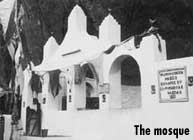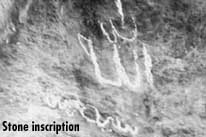 |
 19th July 1998 |
Front Page| |
Historic rock cave mosqueBy Sharm AboosallyIn the month of Rabil-ul- Akhir in the Islamic calendar, which begins on July 24, around 25,000 Muslims from Sri Lanka and other parts of the world will visit Dafter Jailany in Kuragala- a religious and historical site dating back to the 10th century AD. Here they will worship and honour the memory of the greatest saint in Islam- Qutab Muhiyadeen Abdul Cader Jailany, who visited the site over 1,000 years ago.
Kuragala is situated at the end of the Balangoda plateau and ancient steps prove that this had been one of the passes to the Sabaragamuwa hills. Imbulamure, Pollamure and Mollamure villages, which derive their names from "mure" -the old watch posts to guard these passes from invaders are in the same vicinity. Mollamure is a few miles from the old route to Jailany. According to Van Sanden in his book Sonahar an ancient Arab Kingdom existed around Kalah or Galle as far back as 200 BC and the route that the Arab traders took from Galle to Ratnapura in search of precious gemstones could not be much different from the one through Kuragala. Each year at the beginning of the month of Rabil- ul- Akhir, a flag hoisting ceremony takes place in Dafter Jailany, where flags with the name of the saint are raised. Over 1,000 flags can be counted and devotees make vows . Many miraculous stories are associated with this sacred place. One such story is about a dumb boy who was brought here as a last resort after unsuccessful efforts to help him. The boy was kept for three days in the mosque and on the third day, as the boy's father was praying, the boy had approached him and spoken to him. During the month-long ceremonies, a mowlood, or prayers, are recited each day and the festival culminates at the end of the month with a ratheeb, or religious recital. Another feature of the ceremony, is the participation of fakirs or dervishes , mainly from the Eastern province. The fakirs conduct a special prayer called the Rifai- Ratheeb, where they invoke the blessings of the saint and pierce themselves with sharp knives and stakes through their cheeks and tongues. The saint, Qutab Muhiyadeen Abdul Cader Jailany, was born in 1077 AD in present day Iran.He is seen as one of Islam's greatest saints. It is likely that Abdul Cader Jailany visited Sri Lanka at some time during 496 AH to 521 AH or from 1103 AD to 1128 AD. In the 10th and 11th centuries, Many people travelled between the port city of Basarah in the Middle East and Galle. It is therefore possible that the saint travelled from Basarah to Galle and then from there to Adam's Peak via Kuragala. In his writings, the famous Arab traveller, Ibn Batuta, writes of a famous Muslim shrine on the roadway to Adam's Peak which one Khader, or Khider is said to have sanctified by his visit.
Other saints who have reportedly visited Jailany while travelling to Adam's Peak include Shaaul Hameed Ra, who is buried in Nagnoor, India . Another is Sheikh Madar Raliullah. The story goes that while he was brushing his teeth with a twig standing on the Hituangala rock, which overlooks a sheer drop to the Kaltota plains below, the Sheikh had thrown the twig in the air and it is said to have landed in a place called Welipotha and grown into the famous Mal Madara tree, the only flowering Madara tree in Sri Lanka whose branches no animal or serpent will approach. Other interesting facts about the historic site include the fact that below Hituwangala rock, called Kai Adi Malai in Tamil, where the mosque is located, runs a clear stream with plenty of water even during the dry season. Across this source of water is the rock where the cave in which the saint meditated is found- a magnificent retreat commanding a view over the Bintenna plains . This cave is now an archaeological preserve. Below the cave is a well which is said to contain many minerals and which some believe will cure many ailments. Others stories, miraculous in nature , which revolve around Dafter Jailany include the rescue of two children who had fallen 50 feet through a crevice in to the cave near the location where the saint had meditated . Rescue efforts were in vain until days later ,a young boy climbed down the crevice on a rope. He found the children unharmed . They said that a man they could not recognise had comforted them and fed them with milk and bananas before he disappeared. While the site dates over 1,000 years , it was rediscovered around 150 years ago when a holy man, or masthan, from the Nicobar Islands in India arrived in Balangoda. In 1857, there is a record by the Government Agent in the Katcheri in Ratnapura which notes the discovery of a site sacred to Muslims, and this date coincides with the rediscovery of Dafter Jailany by the holy man from India. In 1989, the Government Agent of Ratnapura had visited the site on invitation by the Muslims in the area and had afforded them many of the amenities and facilities needed to carry out their religious ceremonies. From that time, the late C.L.M Marikkar of Balangoda and others in the area had taken interest in Dafter Jailany and constructed a mosque for prayer . In 1936 , the late Justice Akbar , while in the Supreme Court , had regularised a set of rules to administer the site and appointed a Board of Trustees, which was made an order of the District Court in Ratnapura. Today, Dafter Jailany and its surroundings are administered to according to these regulations by a Board of Trustees. While visitors to Dafter Jailany are predominantly Muslims, people of other denominations, mainly Buddhists in the area, also visit the place and consider it sacred. |
||
 |
More Plus * How Tigers prey on cubs
Front Page| News/Comment| Editorial/Opinion| Business| Sports | Mirror Magazine |
|
 |
Please send your comments and suggestions on this web site to |
|
 Dafter
Jailany, with its historic rock cave mosque , is situated in the midst
of dense forest 16 miles from Balangoda in the Sabaragamuwa Province. Ancient
Arab writings, carvings and tombstones, ones dating back to the 10th century
AD , show that Muslim traders have used this site as a resting place and
a place for prayer for centuries.
Dafter
Jailany, with its historic rock cave mosque , is situated in the midst
of dense forest 16 miles from Balangoda in the Sabaragamuwa Province. Ancient
Arab writings, carvings and tombstones, ones dating back to the 10th century
AD , show that Muslim traders have used this site as a resting place and
a place for prayer for centuries. Other
indications to the truth of the theory include a tomb stone dating to the
10th century AD found 12 feet below the surface, which was discovered while
excavations were carried out in 1922. The tomb stone bore the inscription,
" Darwesh Mohiyadeen Darwesh", which means disciple of Mohiyadeen.
Other Arab inscriptions over 1000 years old can be found, some of which
have not yet been deciphered. In the light of the historical value of the
inscriptions, the Dept. of Archaeology would do well to preserve them.
Other
indications to the truth of the theory include a tomb stone dating to the
10th century AD found 12 feet below the surface, which was discovered while
excavations were carried out in 1922. The tomb stone bore the inscription,
" Darwesh Mohiyadeen Darwesh", which means disciple of Mohiyadeen.
Other Arab inscriptions over 1000 years old can be found, some of which
have not yet been deciphered. In the light of the historical value of the
inscriptions, the Dept. of Archaeology would do well to preserve them.